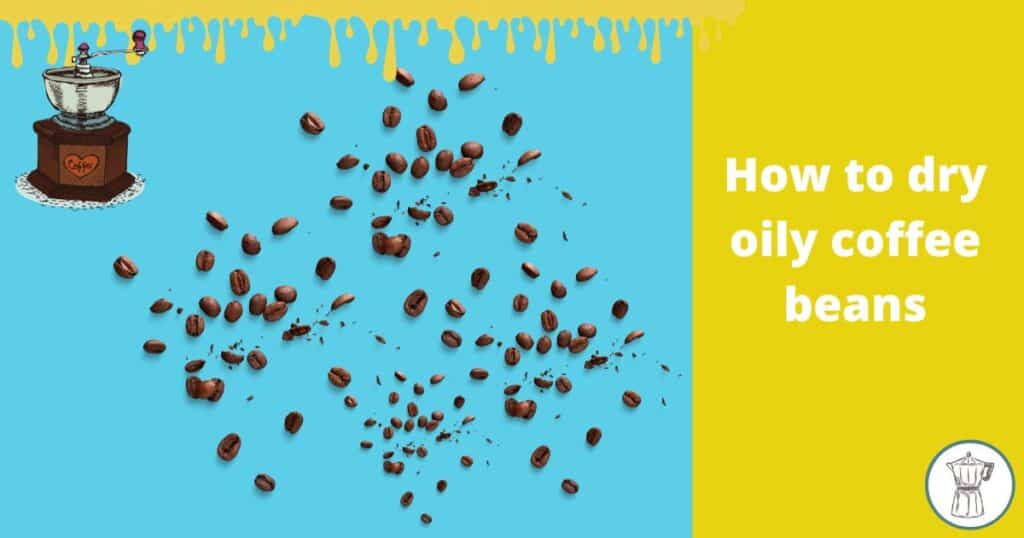Do you know how to dry oily coffee beans the right way?
The other day I bought a new pack of dark roast coffee beans and I was curious to try it at home; it was the first time I had purchased this brand. Interestingly, when I opened the pack I noticed that the coffee beans were oily which was something I hadn’t seen in my life. I went online and did research to learn why this happens and how to dry oily coffee beans. Stick around, I go over a simple yet effective way to dry such oily beans and share brewing tips along the way.
Let’s dive straight into it.
How to dry oily coffee beans?
Dry oily coffee beans by putting them in the oven for 5 minutes at 93.3-107.2°C (200-225F). Use a piece of foil to spread them before baking them. Once you take the beans out, they should be dry. Repeat the process if need be.
What makes coffee beans oily?
Did you know that the longer the beans are roasted, the more the chances of turning oily?
This practically means that dark roast coffee beans are going to be more oily than medium and light. The process of roasting makes coffee beans extract their lipids (which are about 15% of a coffee bean) and for this reason coffee beans become oily.
Let’s be more scientific: while coffee beans are roasted they become more porous (coffee beans release steam Carbon Dioxide and Carbon Monoxide) and the moisture inside the beans comes out. This forces coffee beans to become oily.
It’s also important to note that Arabica coffee beans tend to be slightly more oily than Robusta.
Is it OK if your coffee beans are oily?
Is it a terrible thing if your coffee beans are oily?
Should you get rid of them?
The short answer is: NO
You shouldn’t get rid of them as we’re going to see in this article. There are different ways you can dry your coffee beans and brew coffee as normal as if they wouldn’t have been oily.
As mentioned above, it’s expected for dark roast coffee beans to be oily; it’s absolutely not a problem if the coffee beans you purchased are oily.
Carbonisation of coffee affects how oily your coffee beans are going to be.
Let’s take a look at the 3 main coffee roast types to help you understand the major differences between dark roast coffee beans with the other 2 categories.
Dark roast
Dark roast coffee beans as you might have guessed are called dark because of their dark colour. They’re roasted the longest at around 430-450 F degrees and are the least acidic out of the 3 categories – the longer you roast the beans the less acidic they are. They have a dark chocolaty taste and are ideal for making espresso, French Vanilla and americano.
Medium roast
Medium roast coffee beans have more mellow flavours and aromas. They are roasted at 400-430 F. They are the most popular coffee bean roast type as they aren’t as strong as dark and fruity as light roast either. They are ideal for making cappuccino and latte.
Light (Blonde) roast
Light blonde roast coffee beans are great if you prefer your coffee to be fruity and tangy. They are roasted the least time out of the 3 at around 350-400 F degrees and they’re recommended for making pour-over and drip coffee.
Is it OK to grind oily coffee beans?
There is a catch when you grind oily coffee beans.
The grinder you’re going to use should be a strong one, because you’re giving it a tough task to tackle. Because the coffee beans are going to be oily, this will add an extra layer of friction and slow down grinding. Plus, the coffee grounds might not be too even, meaning that you won’t have a full-of-flavour espresso – far from it.
This might damage your grinder and it’s not worth purchasing a new grinder every now and again because your coffee beans are oily.
It’s wise to dry your coffee beans before grinding them.
4 Methods of drying oily coffee beans
Let’s talk about 4 different methods of drying oily coffee beans.
1. A 4-step method to dry oily coffee beans
Let’s go over the 4-step method for drying oily coffee beans.
- Step 1: Cut a piece of foil and spread the oily coffee beans on it
- Step 2: Turn the oven on at 200-225F degrees and put the coffee beans in
- Step 3: Pay close attention to it as the coffee beans can be burnt easily
- Step 4: Once they look perfectly dry turn the oven off, take them out and let them cool before going ahead and making coffee with them
Top tip: It’s wise to say it 1 more time that it’s easy to burn the beans; pay close attention to ensure you take them out of the oven at the right time.
2. An alternative method for drying oily coffee beans
Do you find baking the coffee beans too much work or even you’re afraid of burning your oily coffee beans?
Don’t fret. There’s an alternative way of drying oily coffee beans.
Here’s what you need to do:
Put the oily coffee beans in a container and place perfectly dry coffee beans as well. Make sure you mix them up properly and leave them some time.
What is going to happen is the dry coffee beans will absorb some of the oil and the oily coffee beans are going to be way less oily.
Are your beans still oily? Add some more dry ones to the ball and mix them up properly.
3. Allow coffee beans to dry naturally
This method is suitable for anyone with patience.
Why is that?
It takes longer to dry your coffee beans this way; if you’re desperate to brew with the coffee beans, I suggest you use 1 of the other ways.
All you need to do is use a kitchen roll and spread the coffee beans on it. The paper will slowly start to absorb the oil from the coffee beans to the point that the coffee beans will be dry enough from brewing.
4. Place the coffee beans in a food dehydrator
You’ll need to have a dehydrator to dry your coffee beans this way.
What you need to do is put the oily coffee beans on 1 of the trays at around 140-150 F degrees. Pay close attention to the coffee beans as they can easily get burned.
This is a quick yet effective way to dry your coffee beans.
Ways to stop coffee beans from becoming oily
The sooner you use them the less likely it is to turn oily.
Let me elaborate on this:
When you buy your coffee beans, it’s wise to go ahead and use them, otherwise, if you keep them for too long in the container, they might turn oily. So, it’s so much better to buy coffee in small quantities even if there are special offers online or in supermarkets.
Other simple tips to keep in mind are:
- Keep your coffee beans in a dark place and away from moisture
- Make sure you clean the tin or bowl you typically keep your coffee beans (if it’s not clean properly, oil from the inside might be transferred to the coffee beans.
- Go for either light or medium roast coffee beans
Why do baristas and coffee snobs DON’T like oily coffee beans?
There’s the misconception that oily coffee beans don’t brew great coffee.
There are 2 issues that deter baristas and coffee snobs from using oily coffee beans:
- They aren’t ground easily: Oil creates extra friction in grinding and results in uneven coffee grounds. The end result isn’t great.
- They leave more oil on the inside of the coffee machine: Because these kinda beans are oily they leave more oil on the inside of the machine, meaning that the machine needs cleaning more often and in case not much cleaning is done, then the coffee brewed each time is going to taste bad
When to dry oily coffee beans vs. when to buy a new coffee pack
Have you tried at least 1 of the methods discussed above and your coffee beans are still oily?
If the answer is ‘yes’, I suggest you get rid of your beans and buy another pack with fresh coffee beans.
It’s not worth spending too much time trying to dry your coffee beans, especially if we’re talking about a small amount.
Another reason to throw away your coffee beans is you tried the baking or dehydration methods and the beans got burned.
Do yourself a favour and purchase fresh coffee beans.
Other ways to use oily coffee beans
In case you don’t really want to brew coffee with your oily coffee beans there are other ways you can use them.
Let’s talk about those alternative ways:
- You can make compost and spread it on your grass which is going to be an excellent fertiliser
- Use it on the edges of your garden to keep away snails and other insects from your grass
- Put a small portion in your fridge to make it smell wonderfully and force bad smells to go away
- Use a foil and put them in to burn them to keep away mosquitos from your house
- Use them to make espresso powder and make delicious cakes
Let’s wrap it up
Do you know how to dry oily coffee beans now? Since you bought those coffee beans, it’s wise to know a couple of ways to dry them, so you can use them for brewing. Stay tuned, as I’m going to be publishing more comprehensive guides brewing and coffee gear.
FAQs
Let’s go over a bunch of FAQs to help you understand more about oily coffee beans.
How do you remove moisture from coffee beans?
A good way to remove moisture from coffee beans is during the roasting process. More specifically to turn the temperature down towards the end of the process.
How do you dry wet coffee beans?
To dry wet coffee beans use kitchen roll or a cloth and spread them in order to dry. You can also use a hair dresser from a distance to dry the coffee beans faster.
Are oily coffee beans fresh?
Oily coffee beans aren’t fresh, the longer they stay in the container you keep your coffee beans in, the more likely they are going to turn oily. It’s vital to clean your coffee bean container frequently; oil from the inside will be transferred to the coffee beans and turn them oily.
Are oily coffee beans better than dry?
Oily coffee beans aren’t better than dry because it’s harder to grind them; they might damage your grinder. Another reason oily coffee beans aren’t better than dry is that the coffee ground with them is uneven and your brew isn’t going to taste as good as if you would have used evenly ground coffee beans.
Do oily coffee beans make coffee as bold as non-oily ones?
Oily coffee beans don’t make as bold coffee as non-oily coffee beans because oily coffee beans aren’t ground evenly. This means that during the brewing process not much of the flavours and aromas from the coffee beans are extracted which practically is translated into a less bold brew.

- How to Remove Coffee Stains From Countertop The Easy Way - December 21, 2023
- Can You Reuse Coffee Grounds in French Press? Truth Inside - December 12, 2023
- Can Expired Coffee Creamer Make You Sick? 3 Ways to Find Out - December 9, 2023
